A Critical Analysis: Environmental Protection in India and China
VerifiedAdded on 2023/06/11
|7
|1728
|204
Essay
AI Summary
This essay examines the effectiveness of environmental protection measures undertaken by the Indian and Chinese governments to combat air and water pollution. It argues that despite various initiatives and policies, these efforts have largely been unsuccessful. The essay highlights the persistent pollution in the Mithi River in India and the worsening air quality in China's Yangtze River Delta as examples of the failure of these measures. While acknowledging some successful attempts, such as the Water Act in India and anti-pollution measures in China, the essay concludes that both governments need to implement stricter policies and regulations to achieve significant improvements in environmental quality. Desklib offers a wide range of resources including similar essays and study materials for students.
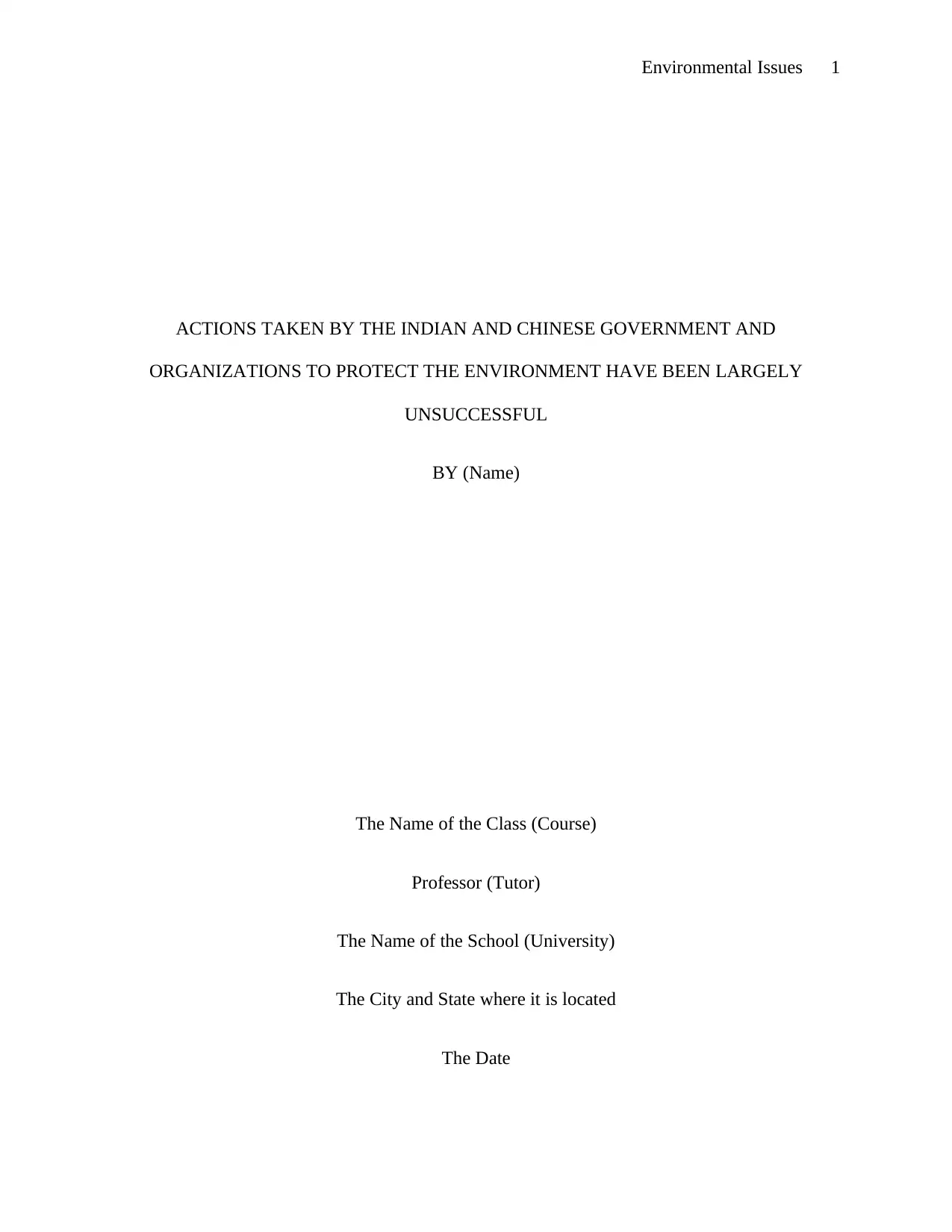
Environmental Issues 1
ACTIONS TAKEN BY THE INDIAN AND CHINESE GOVERNMENT AND
ORGANIZATIONS TO PROTECT THE ENVIRONMENT HAVE BEEN LARGELY
UNSUCCESSFUL
BY (Name)
The Name of the Class (Course)
Professor (Tutor)
The Name of the School (University)
The City and State where it is located
The Date
ACTIONS TAKEN BY THE INDIAN AND CHINESE GOVERNMENT AND
ORGANIZATIONS TO PROTECT THE ENVIRONMENT HAVE BEEN LARGELY
UNSUCCESSFUL
BY (Name)
The Name of the Class (Course)
Professor (Tutor)
The Name of the School (University)
The City and State where it is located
The Date
Paraphrase This Document
Need a fresh take? Get an instant paraphrase of this document with our AI Paraphraser
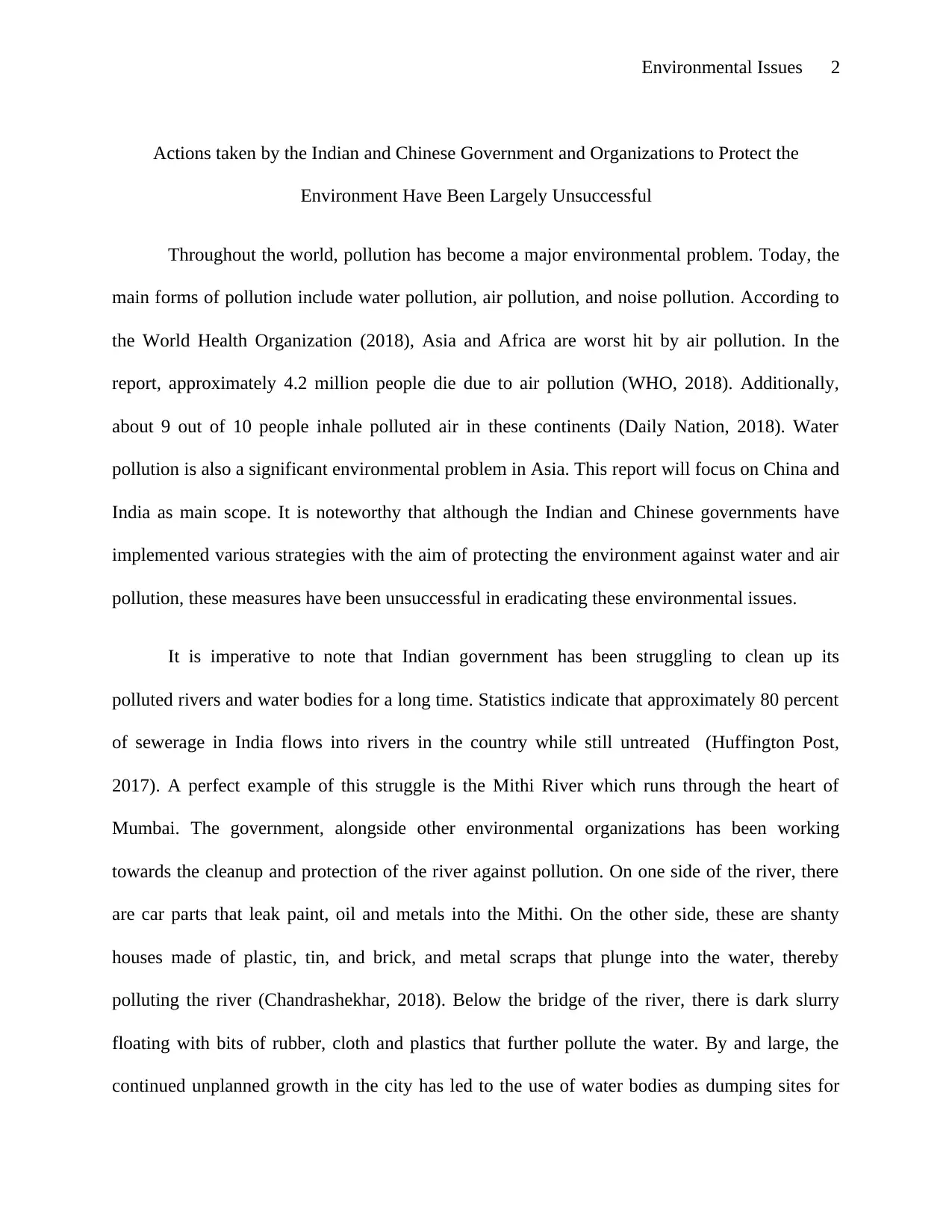
Environmental Issues 2
Actions taken by the Indian and Chinese Government and Organizations to Protect the
Environment Have Been Largely Unsuccessful
Throughout the world, pollution has become a major environmental problem. Today, the
main forms of pollution include water pollution, air pollution, and noise pollution. According to
the World Health Organization (2018), Asia and Africa are worst hit by air pollution. In the
report, approximately 4.2 million people die due to air pollution (WHO, 2018). Additionally,
about 9 out of 10 people inhale polluted air in these continents (Daily Nation, 2018). Water
pollution is also a significant environmental problem in Asia. This report will focus on China and
India as main scope. It is noteworthy that although the Indian and Chinese governments have
implemented various strategies with the aim of protecting the environment against water and air
pollution, these measures have been unsuccessful in eradicating these environmental issues.
It is imperative to note that Indian government has been struggling to clean up its
polluted rivers and water bodies for a long time. Statistics indicate that approximately 80 percent
of sewerage in India flows into rivers in the country while still untreated (Huffington Post,
2017). A perfect example of this struggle is the Mithi River which runs through the heart of
Mumbai. The government, alongside other environmental organizations has been working
towards the cleanup and protection of the river against pollution. On one side of the river, there
are car parts that leak paint, oil and metals into the Mithi. On the other side, these are shanty
houses made of plastic, tin, and brick, and metal scraps that plunge into the water, thereby
polluting the river (Chandrashekhar, 2018). Below the bridge of the river, there is dark slurry
floating with bits of rubber, cloth and plastics that further pollute the water. By and large, the
continued unplanned growth in the city has led to the use of water bodies as dumping sites for
Actions taken by the Indian and Chinese Government and Organizations to Protect the
Environment Have Been Largely Unsuccessful
Throughout the world, pollution has become a major environmental problem. Today, the
main forms of pollution include water pollution, air pollution, and noise pollution. According to
the World Health Organization (2018), Asia and Africa are worst hit by air pollution. In the
report, approximately 4.2 million people die due to air pollution (WHO, 2018). Additionally,
about 9 out of 10 people inhale polluted air in these continents (Daily Nation, 2018). Water
pollution is also a significant environmental problem in Asia. This report will focus on China and
India as main scope. It is noteworthy that although the Indian and Chinese governments have
implemented various strategies with the aim of protecting the environment against water and air
pollution, these measures have been unsuccessful in eradicating these environmental issues.
It is imperative to note that Indian government has been struggling to clean up its
polluted rivers and water bodies for a long time. Statistics indicate that approximately 80 percent
of sewerage in India flows into rivers in the country while still untreated (Huffington Post,
2017). A perfect example of this struggle is the Mithi River which runs through the heart of
Mumbai. The government, alongside other environmental organizations has been working
towards the cleanup and protection of the river against pollution. On one side of the river, there
are car parts that leak paint, oil and metals into the Mithi. On the other side, these are shanty
houses made of plastic, tin, and brick, and metal scraps that plunge into the water, thereby
polluting the river (Chandrashekhar, 2018). Below the bridge of the river, there is dark slurry
floating with bits of rubber, cloth and plastics that further pollute the water. By and large, the
continued unplanned growth in the city has led to the use of water bodies as dumping sites for
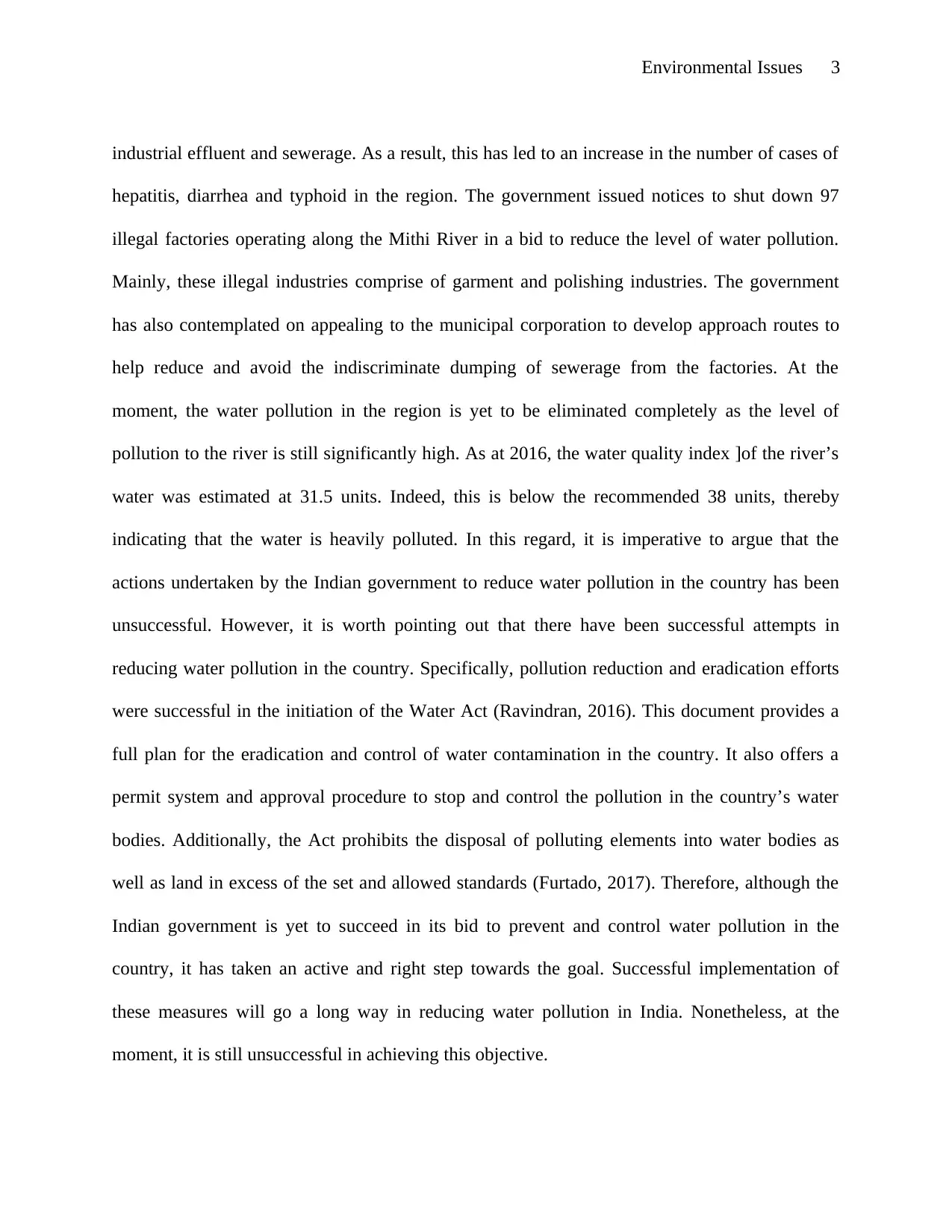
Environmental Issues 3
industrial effluent and sewerage. As a result, this has led to an increase in the number of cases of
hepatitis, diarrhea and typhoid in the region. The government issued notices to shut down 97
illegal factories operating along the Mithi River in a bid to reduce the level of water pollution.
Mainly, these illegal industries comprise of garment and polishing industries. The government
has also contemplated on appealing to the municipal corporation to develop approach routes to
help reduce and avoid the indiscriminate dumping of sewerage from the factories. At the
moment, the water pollution in the region is yet to be eliminated completely as the level of
pollution to the river is still significantly high. As at 2016, the water quality index ]of the river’s
water was estimated at 31.5 units. Indeed, this is below the recommended 38 units, thereby
indicating that the water is heavily polluted. In this regard, it is imperative to argue that the
actions undertaken by the Indian government to reduce water pollution in the country has been
unsuccessful. However, it is worth pointing out that there have been successful attempts in
reducing water pollution in the country. Specifically, pollution reduction and eradication efforts
were successful in the initiation of the Water Act (Ravindran, 2016). This document provides a
full plan for the eradication and control of water contamination in the country. It also offers a
permit system and approval procedure to stop and control the pollution in the country’s water
bodies. Additionally, the Act prohibits the disposal of polluting elements into water bodies as
well as land in excess of the set and allowed standards (Furtado, 2017). Therefore, although the
Indian government is yet to succeed in its bid to prevent and control water pollution in the
country, it has taken an active and right step towards the goal. Successful implementation of
these measures will go a long way in reducing water pollution in India. Nonetheless, at the
moment, it is still unsuccessful in achieving this objective.
industrial effluent and sewerage. As a result, this has led to an increase in the number of cases of
hepatitis, diarrhea and typhoid in the region. The government issued notices to shut down 97
illegal factories operating along the Mithi River in a bid to reduce the level of water pollution.
Mainly, these illegal industries comprise of garment and polishing industries. The government
has also contemplated on appealing to the municipal corporation to develop approach routes to
help reduce and avoid the indiscriminate dumping of sewerage from the factories. At the
moment, the water pollution in the region is yet to be eliminated completely as the level of
pollution to the river is still significantly high. As at 2016, the water quality index ]of the river’s
water was estimated at 31.5 units. Indeed, this is below the recommended 38 units, thereby
indicating that the water is heavily polluted. In this regard, it is imperative to argue that the
actions undertaken by the Indian government to reduce water pollution in the country has been
unsuccessful. However, it is worth pointing out that there have been successful attempts in
reducing water pollution in the country. Specifically, pollution reduction and eradication efforts
were successful in the initiation of the Water Act (Ravindran, 2016). This document provides a
full plan for the eradication and control of water contamination in the country. It also offers a
permit system and approval procedure to stop and control the pollution in the country’s water
bodies. Additionally, the Act prohibits the disposal of polluting elements into water bodies as
well as land in excess of the set and allowed standards (Furtado, 2017). Therefore, although the
Indian government is yet to succeed in its bid to prevent and control water pollution in the
country, it has taken an active and right step towards the goal. Successful implementation of
these measures will go a long way in reducing water pollution in India. Nonetheless, at the
moment, it is still unsuccessful in achieving this objective.
⊘ This is a preview!⊘
Do you want full access?
Subscribe today to unlock all pages.

Trusted by 1+ million students worldwide
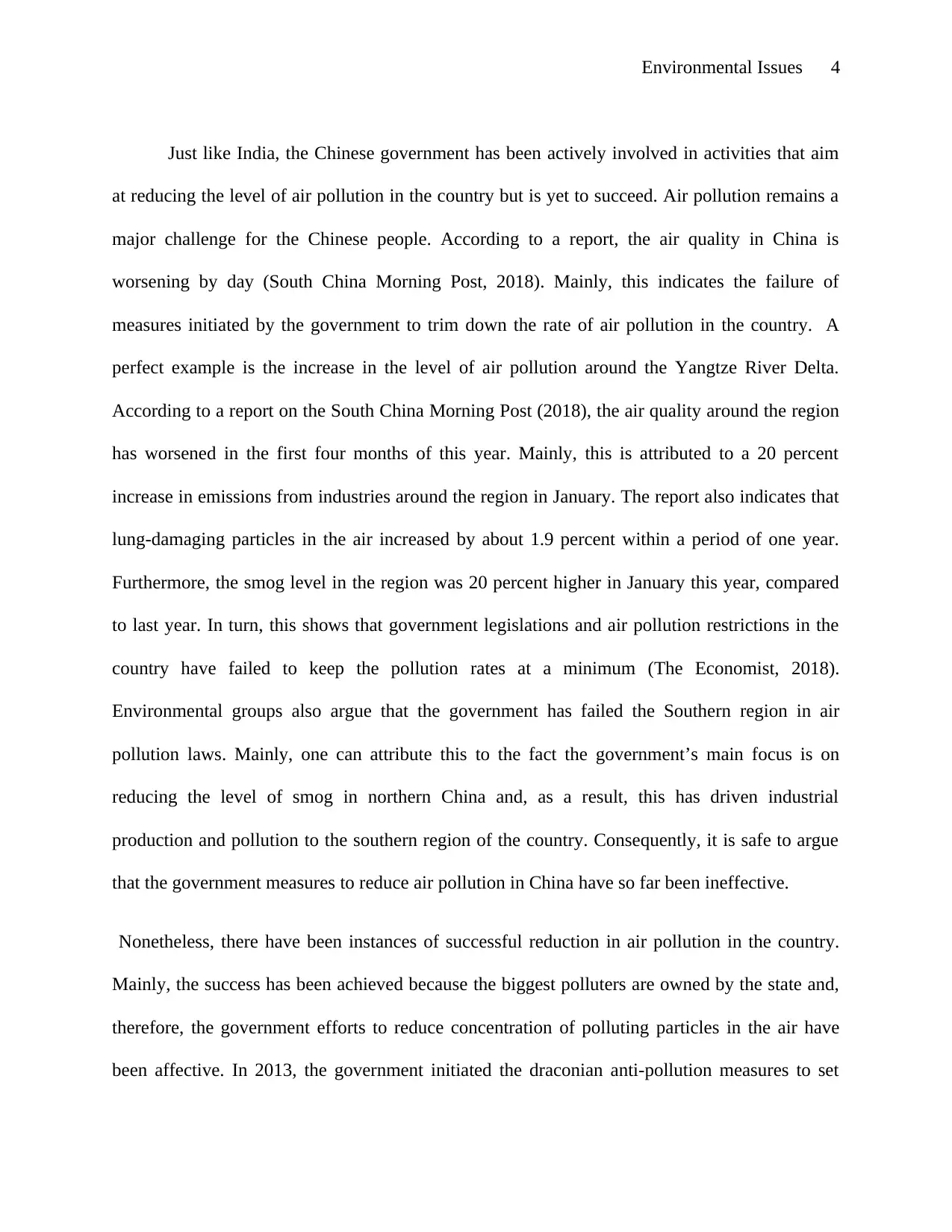
Environmental Issues 4
Just like India, the Chinese government has been actively involved in activities that aim
at reducing the level of air pollution in the country but is yet to succeed. Air pollution remains a
major challenge for the Chinese people. According to a report, the air quality in China is
worsening by day (South China Morning Post, 2018). Mainly, this indicates the failure of
measures initiated by the government to trim down the rate of air pollution in the country. A
perfect example is the increase in the level of air pollution around the Yangtze River Delta.
According to a report on the South China Morning Post (2018), the air quality around the region
has worsened in the first four months of this year. Mainly, this is attributed to a 20 percent
increase in emissions from industries around the region in January. The report also indicates that
lung-damaging particles in the air increased by about 1.9 percent within a period of one year.
Furthermore, the smog level in the region was 20 percent higher in January this year, compared
to last year. In turn, this shows that government legislations and air pollution restrictions in the
country have failed to keep the pollution rates at a minimum (The Economist, 2018).
Environmental groups also argue that the government has failed the Southern region in air
pollution laws. Mainly, one can attribute this to the fact the government’s main focus is on
reducing the level of smog in northern China and, as a result, this has driven industrial
production and pollution to the southern region of the country. Consequently, it is safe to argue
that the government measures to reduce air pollution in China have so far been ineffective.
Nonetheless, there have been instances of successful reduction in air pollution in the country.
Mainly, the success has been achieved because the biggest polluters are owned by the state and,
therefore, the government efforts to reduce concentration of polluting particles in the air have
been affective. In 2013, the government initiated the draconian anti-pollution measures to set
Just like India, the Chinese government has been actively involved in activities that aim
at reducing the level of air pollution in the country but is yet to succeed. Air pollution remains a
major challenge for the Chinese people. According to a report, the air quality in China is
worsening by day (South China Morning Post, 2018). Mainly, this indicates the failure of
measures initiated by the government to trim down the rate of air pollution in the country. A
perfect example is the increase in the level of air pollution around the Yangtze River Delta.
According to a report on the South China Morning Post (2018), the air quality around the region
has worsened in the first four months of this year. Mainly, this is attributed to a 20 percent
increase in emissions from industries around the region in January. The report also indicates that
lung-damaging particles in the air increased by about 1.9 percent within a period of one year.
Furthermore, the smog level in the region was 20 percent higher in January this year, compared
to last year. In turn, this shows that government legislations and air pollution restrictions in the
country have failed to keep the pollution rates at a minimum (The Economist, 2018).
Environmental groups also argue that the government has failed the Southern region in air
pollution laws. Mainly, one can attribute this to the fact the government’s main focus is on
reducing the level of smog in northern China and, as a result, this has driven industrial
production and pollution to the southern region of the country. Consequently, it is safe to argue
that the government measures to reduce air pollution in China have so far been ineffective.
Nonetheless, there have been instances of successful reduction in air pollution in the country.
Mainly, the success has been achieved because the biggest polluters are owned by the state and,
therefore, the government efforts to reduce concentration of polluting particles in the air have
been affective. In 2013, the government initiated the draconian anti-pollution measures to set
Paraphrase This Document
Need a fresh take? Get an instant paraphrase of this document with our AI Paraphraser
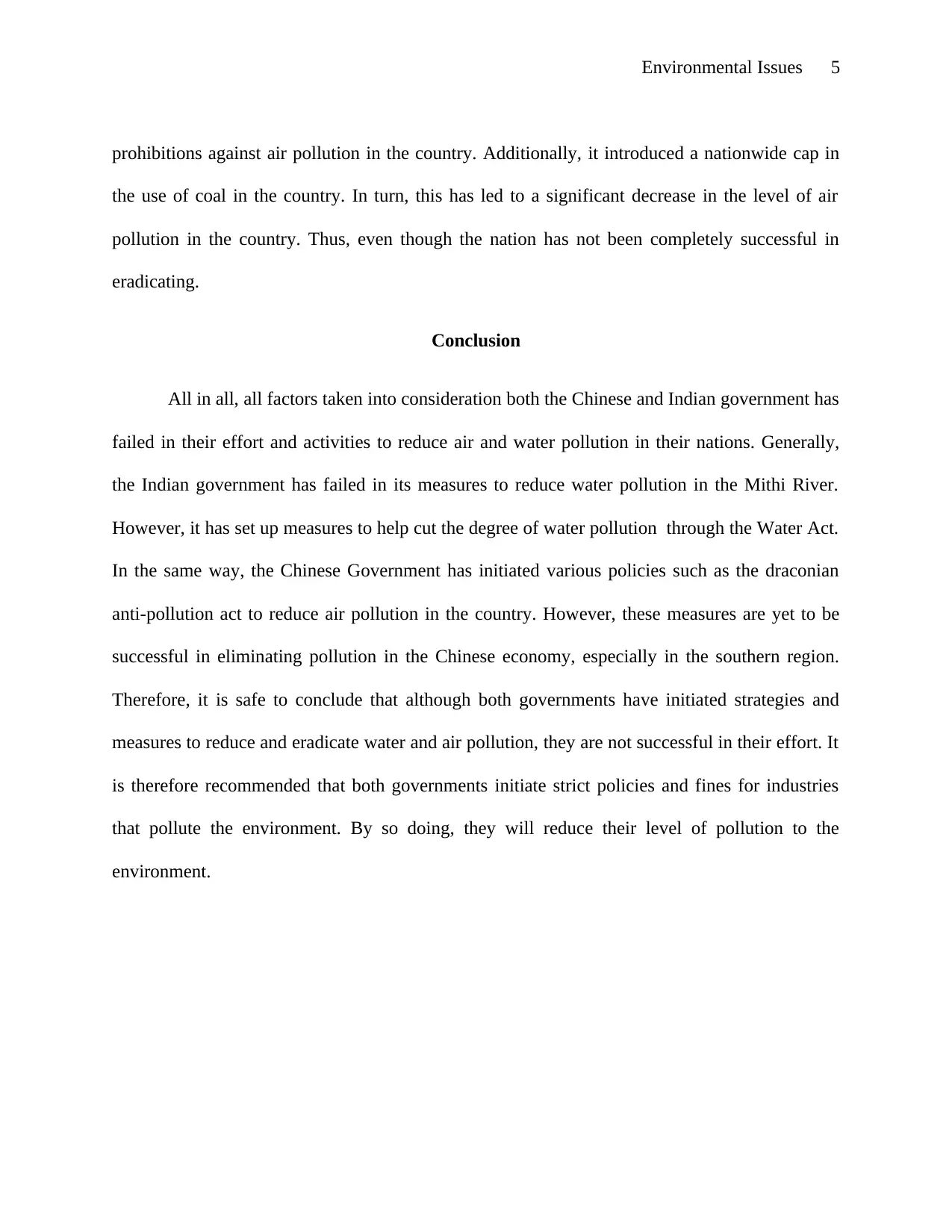
Environmental Issues 5
prohibitions against air pollution in the country. Additionally, it introduced a nationwide cap in
the use of coal in the country. In turn, this has led to a significant decrease in the level of air
pollution in the country. Thus, even though the nation has not been completely successful in
eradicating.
Conclusion
All in all, all factors taken into consideration both the Chinese and Indian government has
failed in their effort and activities to reduce air and water pollution in their nations. Generally,
the Indian government has failed in its measures to reduce water pollution in the Mithi River.
However, it has set up measures to help cut the degree of water pollution through the Water Act.
In the same way, the Chinese Government has initiated various policies such as the draconian
anti-pollution act to reduce air pollution in the country. However, these measures are yet to be
successful in eliminating pollution in the Chinese economy, especially in the southern region.
Therefore, it is safe to conclude that although both governments have initiated strategies and
measures to reduce and eradicate water and air pollution, they are not successful in their effort. It
is therefore recommended that both governments initiate strict policies and fines for industries
that pollute the environment. By so doing, they will reduce their level of pollution to the
environment.
prohibitions against air pollution in the country. Additionally, it introduced a nationwide cap in
the use of coal in the country. In turn, this has led to a significant decrease in the level of air
pollution in the country. Thus, even though the nation has not been completely successful in
eradicating.
Conclusion
All in all, all factors taken into consideration both the Chinese and Indian government has
failed in their effort and activities to reduce air and water pollution in their nations. Generally,
the Indian government has failed in its measures to reduce water pollution in the Mithi River.
However, it has set up measures to help cut the degree of water pollution through the Water Act.
In the same way, the Chinese Government has initiated various policies such as the draconian
anti-pollution act to reduce air pollution in the country. However, these measures are yet to be
successful in eliminating pollution in the Chinese economy, especially in the southern region.
Therefore, it is safe to conclude that although both governments have initiated strategies and
measures to reduce and eradicate water and air pollution, they are not successful in their effort. It
is therefore recommended that both governments initiate strict policies and fines for industries
that pollute the environment. By so doing, they will reduce their level of pollution to the
environment.
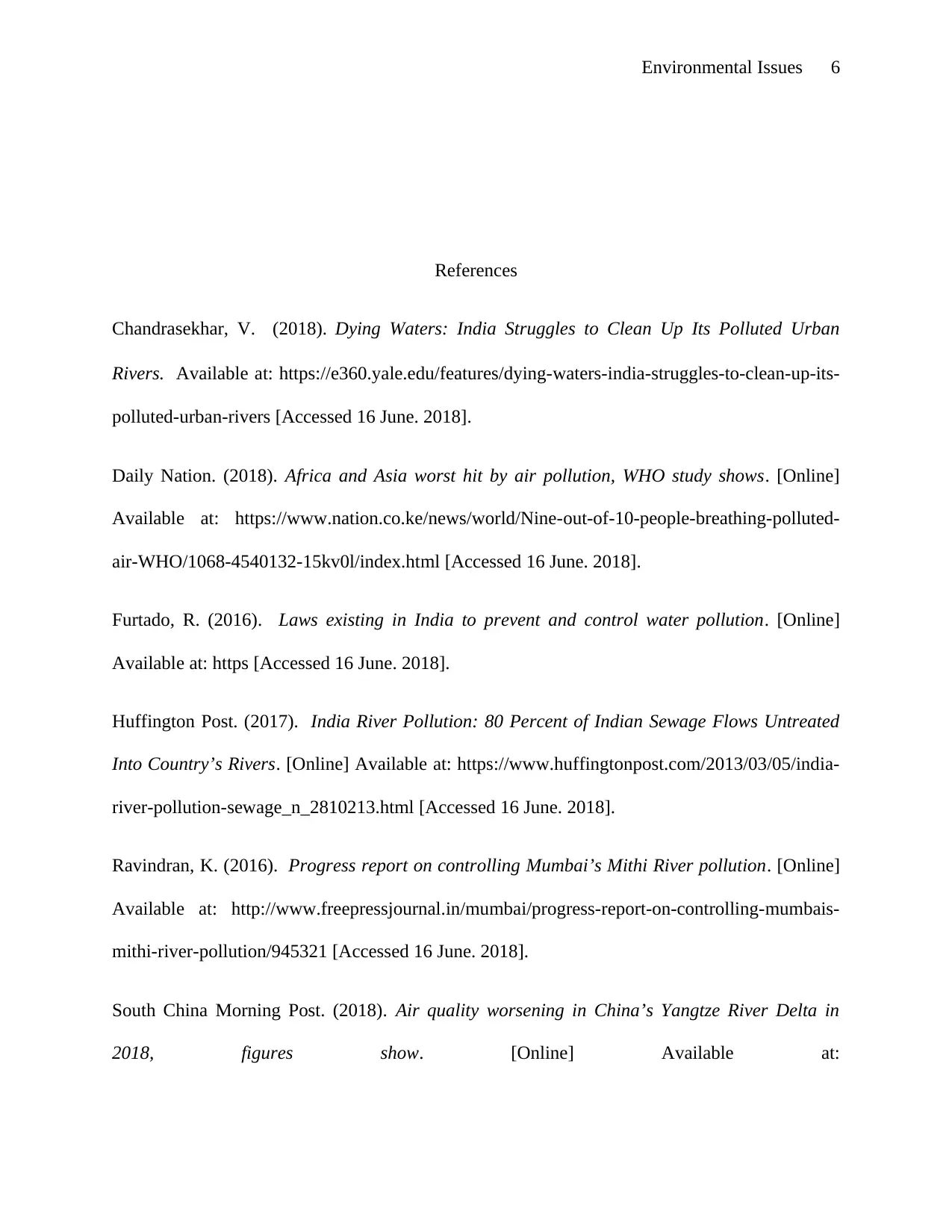
Environmental Issues 6
References
Chandrasekhar, V. (2018). Dying Waters: India Struggles to Clean Up Its Polluted Urban
Rivers. Available at: https://e360.yale.edu/features/dying-waters-india-struggles-to-clean-up-its-
polluted-urban-rivers [Accessed 16 June. 2018].
Daily Nation. (2018). Africa and Asia worst hit by air pollution, WHO study shows. [Online]
Available at: https://www.nation.co.ke/news/world/Nine-out-of-10-people-breathing-polluted-
air-WHO/1068-4540132-15kv0l/index.html [Accessed 16 June. 2018].
Furtado, R. (2016). Laws existing in India to prevent and control water pollution. [Online]
Available at: https [Accessed 16 June. 2018].
Huffington Post. (2017). India River Pollution: 80 Percent of Indian Sewage Flows Untreated
Into Country’s Rivers. [Online] Available at: https://www.huffingtonpost.com/2013/03/05/india-
river-pollution-sewage_n_2810213.html [Accessed 16 June. 2018].
Ravindran, K. (2016). Progress report on controlling Mumbai’s Mithi River pollution. [Online]
Available at: http://www.freepressjournal.in/mumbai/progress-report-on-controlling-mumbais-
mithi-river-pollution/945321 [Accessed 16 June. 2018].
South China Morning Post. (2018). Air quality worsening in China’s Yangtze River Delta in
2018, figures show. [Online] Available at:
References
Chandrasekhar, V. (2018). Dying Waters: India Struggles to Clean Up Its Polluted Urban
Rivers. Available at: https://e360.yale.edu/features/dying-waters-india-struggles-to-clean-up-its-
polluted-urban-rivers [Accessed 16 June. 2018].
Daily Nation. (2018). Africa and Asia worst hit by air pollution, WHO study shows. [Online]
Available at: https://www.nation.co.ke/news/world/Nine-out-of-10-people-breathing-polluted-
air-WHO/1068-4540132-15kv0l/index.html [Accessed 16 June. 2018].
Furtado, R. (2016). Laws existing in India to prevent and control water pollution. [Online]
Available at: https [Accessed 16 June. 2018].
Huffington Post. (2017). India River Pollution: 80 Percent of Indian Sewage Flows Untreated
Into Country’s Rivers. [Online] Available at: https://www.huffingtonpost.com/2013/03/05/india-
river-pollution-sewage_n_2810213.html [Accessed 16 June. 2018].
Ravindran, K. (2016). Progress report on controlling Mumbai’s Mithi River pollution. [Online]
Available at: http://www.freepressjournal.in/mumbai/progress-report-on-controlling-mumbais-
mithi-river-pollution/945321 [Accessed 16 June. 2018].
South China Morning Post. (2018). Air quality worsening in China’s Yangtze River Delta in
2018, figures show. [Online] Available at:
⊘ This is a preview!⊘
Do you want full access?
Subscribe today to unlock all pages.

Trusted by 1+ million students worldwide
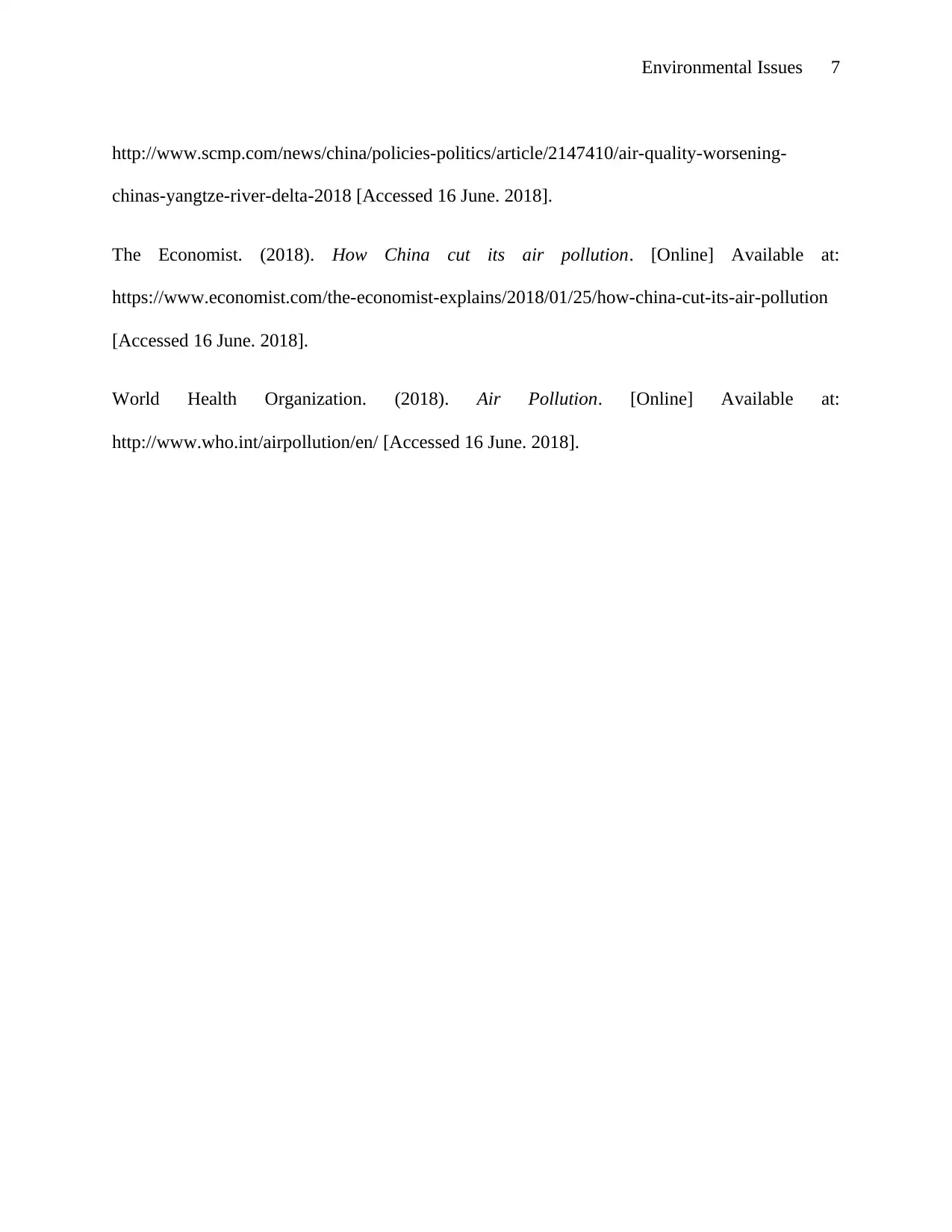
Environmental Issues 7
http://www.scmp.com/news/china/policies-politics/article/2147410/air-quality-worsening-
chinas-yangtze-river-delta-2018 [Accessed 16 June. 2018].
The Economist. (2018). How China cut its air pollution. [Online] Available at:
https://www.economist.com/the-economist-explains/2018/01/25/how-china-cut-its-air-pollution
[Accessed 16 June. 2018].
World Health Organization. (2018). Air Pollution. [Online] Available at:
http://www.who.int/airpollution/en/ [Accessed 16 June. 2018].
http://www.scmp.com/news/china/policies-politics/article/2147410/air-quality-worsening-
chinas-yangtze-river-delta-2018 [Accessed 16 June. 2018].
The Economist. (2018). How China cut its air pollution. [Online] Available at:
https://www.economist.com/the-economist-explains/2018/01/25/how-china-cut-its-air-pollution
[Accessed 16 June. 2018].
World Health Organization. (2018). Air Pollution. [Online] Available at:
http://www.who.int/airpollution/en/ [Accessed 16 June. 2018].
1 out of 7
Related Documents
Your All-in-One AI-Powered Toolkit for Academic Success.
+13062052269
info@desklib.com
Available 24*7 on WhatsApp / Email
![[object Object]](/_next/static/media/star-bottom.7253800d.svg)
Unlock your academic potential
Copyright © 2020–2025 A2Z Services. All Rights Reserved. Developed and managed by ZUCOL.





